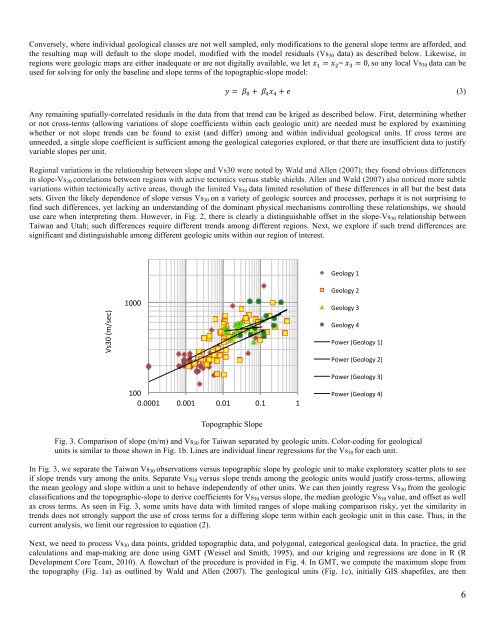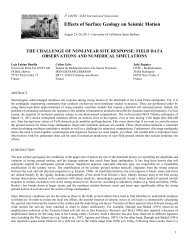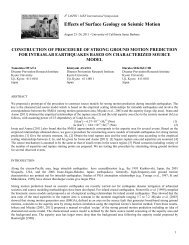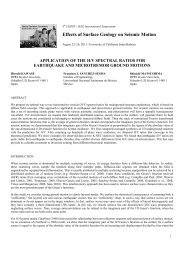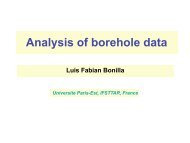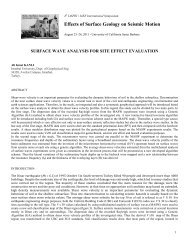a new strategy for developing vs30 maps - ESG4 Conference @ UCSB
a new strategy for developing vs30 maps - ESG4 Conference @ UCSB
a new strategy for developing vs30 maps - ESG4 Conference @ UCSB
Create successful ePaper yourself
Turn your PDF publications into a flip-book with our unique Google optimized e-Paper software.
Conversely, where individual geological classes are not well sampled, only modifications to the general slope terms are af<strong>for</strong>ded, and<br />
the resulting map will default to the slope model, modified with the model residuals (Vs 30 data) as described below. Likewise, in<br />
regions were geologic <strong>maps</strong> are either inadequate or are not digitally available, we let ! ! ! ! ! =!! ! ! !!!so any local Vs 30 data can be<br />
used <strong>for</strong> solving <strong>for</strong> only the baseline and slope terms of the topographic-slope model:<br />
! ! ! ! ! ! !! ! ! ! ! ! (3)<br />
Any remaining spatially-correlated residuals in the data from that trend can be kriged as described below. First, determining whether<br />
or not cross-terms (allowing variations of slope coefficients within each geologic unit) are needed must be explored by examining<br />
whether or not slope trends can be found to exist (and differ) among and within individual geological units. If cross terms are<br />
unneeded, a single slope coefficient is sufficient among the geological categories explored, or that there are insufficient data to justify<br />
variable slopes per unit.<br />
Regional variations in the relationship between slope and Vs30 were noted by Wald and Allen (2007); they found obvious differences<br />
in slope-Vs 30 correlations between regions with active tectonics versus stable shields. Allen and Wald (2007) also noticed more subtle<br />
variations within tectonically active areas, though the limited Vs 30 data limited resolution of these differences in all but the best data<br />
sets. Given the likely dependence of slope versus Vs 30 on a variety of geologic sources and processes, perhaps it is not surprising to<br />
find such differences, yet lacking an understanding of the dominant physical mechanisms controlling these relationships, we should<br />
use care when interpreting them. However, in Fig. 2, there is clearly a distinguishable offset in the slope-Vs 30 relationship between<br />
Taiwan and Utah; such differences require different trends among different regions. Next, we explore if such trend differences are<br />
significant and distinguishable among different geologic units within our region of interest.<br />
.+/0/12#!#<br />
%&'"#()*&+,-#<br />
!"""#<br />
!""#<br />
"$"""!# "$""!# "$"!# "$!# !#<br />
Topographic Slope<br />
.+/0/12#3#<br />
.+/0/12#'#<br />
.+/0/12#4#<br />
5/6+7#(.+/0/12#!-#<br />
5/6+7#(.+/0/12#3-#<br />
5/6+7#(.+/0/12#'-#<br />
5/6+7#(.+/0/12#4-#<br />
Fig. 3. Comparison of slope (m/m) and Vs 30 <strong>for</strong> Taiwan separated by geologic units. Color-coding <strong>for</strong> geological<br />
units is similar to those shown in Fig. 1b. Lines are individual linear regressions <strong>for</strong> the Vs 30 <strong>for</strong> each unit.<br />
In Fig. 3, we separate the Taiwan Vs 30 observations versus topographic slope by geologic unit to make exploratory scatter plots to see<br />
if slope trends vary among the units. Separate Vs 30 versus slope trends among the geologic units would justify cross-terms, allowing<br />
the mean geology and slope within a unit to behave independently of other units. We can then jointly regress Vs 30 from the geologic<br />
classifications and the topographic-slope to derive coefficients <strong>for</strong> Vs 30 versus slope, the median geologic Vs 30 value, and offset as well<br />
as cross terms. As seen in Fig. 3, some units have data with limited ranges of slope making comparison risky, yet the similarity in<br />
trends does not strongly support the use of cross terms <strong>for</strong> a differing slope term within each geologic unit in this case. Thus, in the<br />
current analysis, we limit our regression to equation (2).<br />
Next, we need to process Vs 30 data points, gridded topographic data, and polygonal, categorical geological data. In practice, the grid<br />
calculations and map-making are done using GMT (Wessel and Smith, 1995), and our kriging and regressions are done in R (R<br />
Development Core Team, 2010). A flowchart of the procedure is provided in Fig. 4. In GMT, we compute the maximum slope from<br />
the topography (Fig. 1a) as outlined by Wald and Allen (2007). The geological units (Fig. 1c), initially GIS shapefiles, are then<br />
6


